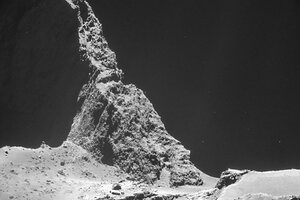How spacecraft chased a comet 300 million miles, and is poised for a landing
On Wednesday, the European Space Agency's Rosetta mission will try for a first-ever landing of a spacecraft on a comet. The comet in question, 67P, is shaped a little like a rubber ducky and is traveling at speeds greater than 34,000 miles per hour.

The picture taken with the navigation camera on Rosetta and released by the European Space Agency ESA shows the boulder-strewn neck region of Comet 67P/Churyumov–Gerasimenko. On Wednesday, the Philae lander will be detached from Rosetta to land on the comet.
European Space Agency/AP
Washington
They’ve had more than a decade to plan this moment, but it still isn’t easy: On Wednesday, a team from the European Space Agency will try for a first-ever soft landing of a spacecraft on a comet.
The comet is rotating, has an odd shape somewhat like a rubber ducky, and travels through space at speeds greater than 34,000 miles per hour.
It also happens to be more than 300 million miles away, which means the mission scientists have to wait 28 minutes for any signals to travel to or from the little lander called Philae.
People on Earth will know if the landing was successful about half an hour after it actually happens.
With that 28-minute caveat, you can track the mission in “real time” by following a video feed from European Space Agency (ESA), as well as updates on the space agency’s blog and Twitter feed. (There are two: click here and here.)
After some initial difficulty powering up the Philae lander, the mission’s flight dynamics team on Wednesday said the mission is on track. If all continues to go as planned, the will craft separate from Rosetta at about 8: 35 universal time Wednesday morning (3:35 a.m. Eastern time in the US), the Associated Press reports.
Touchdown on the comet won’t be confirmed on Earth until about 16:02 universal time (11:02 a.m. Eastern time).
The mission is known as Rosetta, after the craft that has carried the Philae lander all the way to this high-speed rendezvous. Just as the ancient Rosetta Stone helped to unravel mysteries of Egypt’s hieroglyphs, scientists are hoping this mission will yield new insights into ancient comets – their structure, their behavior, and the gases they vent to form a trail in space.
How do you land on a comet, or even get there in the first place?
Here are some of the key steps, thanks to a major “gravity assist” from the ESA’s own Rosetta mission blog.
Step 1 is to leave Earth. That happened back on March 2, 2004, when an Ariane rocket launched from Europe’s spaceport in Kourou, French Guiana.
A vital next step was to pick up some serious speed – and in the right direction to chase the chosen celestial body – namely comet 67P/Churyumov-Gerasimenko. Rosetta performed several “gravity assist” maneuvers, passing near Earth three times and Mars once to gain a slingshot effect from the planets’ mass.
“Rosetta’s gravity-boost swing-bys around Earth in 2005, 2007 and 2009, and Mars in 2007, put us on the right track,” Rosetta Flight Director Andrea Accomazzo explained in an ESA blog post.
But all that still would have only brought Rosetta toward a close brush with comet 67P.
Since May, the ESA team had to fine-tune Rosetta’s speed and direction with 10 key “burns” of the craft's thrusters, with a burn roughly every two weeks.
That brought Rosetta, by early August, to within about 60 miles of the comet’s craggy surface.
Weeks of Rosetta moving in tandem with the comet have allowed the ESA team to select a landing site that blends relatively hospitable terrain with the scientific potential. Once the Philae craft has landed, it will need to use harpoons to secure itself to the surface (due to weak gravity). Then the lander plans to drill into the surface for samples that can be analyzed by its on-board spectrometers.
Some stunning navigation is involved in all this. With Rosetta millions of miles away, the mission’s flight dynamics team back on Earth compared signals from the craft, received at a pair of antennas located far from one another on Earth, to help estimate Rosetta’s location and speed. (The ESA calls this method “delta DOR” for Delta Differential One-way Ranging.)
Since getting close to the comet, images from Rosetta’s on-board cameras have been key navigational tools.
Now comes the moment for more technical prowess – Philae’s hours-long descent toward what researchers hope will be a gentle landing.

